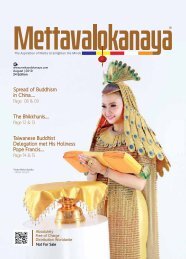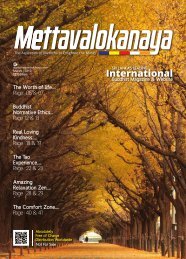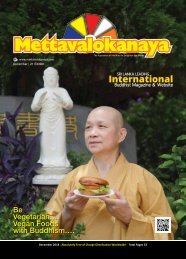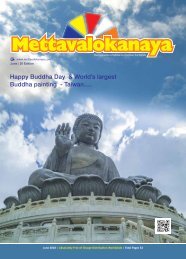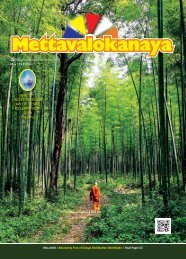#Mettavalokanaya_International_Buddhist_Magazine_May_2021
This is the World’s Most Popular & Leading Monthly International Buddhist Magazine, “Mettavalokanaya” on May 2021 Vesak Edition - 31. https://mettavalokanaya.com/magazine-31/ http://www.mettavalokanaya.com/
This is the World’s Most Popular & Leading Monthly International Buddhist Magazine, “Mettavalokanaya” on May 2021 Vesak Edition - 31.
https://mettavalokanaya.com/magazine-31/
http://www.mettavalokanaya.com/
You also want an ePaper? Increase the reach of your titles
YUMPU automatically turns print PDFs into web optimized ePapers that Google loves.
Children and
Buddhist Temples….
Children are the “life blood”
of our Buddhist temples –
both in our home countries
and in the West. Without the
children’s continued participation
in temple life, temples will simply
cease to be. It is imperative, therefore,
that we keep them involved, keep
them interested, keep making the
Buddha Dhamma relevant, and as
Sangha members and lay ministers,
keep adapting our teaching styles to
the younger generations’ mindsets,
challenges, and daily lives. When the
first wave of Theravada Buddhists
immigrated to the U.S. in the mid-
1960’s to the mid-1990’s, they helped
found and fund the Buddhist temples
that offered their particular ethnic
brand of Buddhism from their home
countries. These temples were staffed
by newly-arriving monks from Sri
Lanka, Thailand, Vietnam, Cambodia,
Laos, and Myanmar. Chinese, Japanese
and South Korean monks had planted
their roots earlier.
The children of these first
immigrants were brought to their
temples on a regular basis, and were
schooled in the Buddha Dhamma by
the monks. They were also exposed to
the rituals, services, celebrations, and
ceremonies brought from the home
country. Some of these children were
born overseas, and some were born
in North America during this threedecade
timeframe. They have since
grown up, completed their educations,
and many of them have started their
own families. They also have moved
to all parts of the continent, opening
new Buddhist temples. This second
generation of Buddhists in the New
World became very familiar with their
temples’ monks, and they often formed
long-lasting bonds with them. For the
most part these young people learned
the native language of the home
country from their families, and they
were more than willing to participate
in their temples’ religious services
and seasonal activities. They were the
first generation of North American
Buddhist Sunday School graduates in
our temple.
The third generation of young
Buddhists, those born in the 1990’s up
to the present time, are, for the most
Most Venerable Aggamaha
Pandita Dr. Walpola Piyananda Thero
Chief Sangha Nayake Thero
of America and President of USA &
Canada Sanga Council, Chief Abbot &
President of Dharma Vijaya Buddhist
Vihara, Los Angeles, California, USA.
part American or Canadian children.
Almost all of them were born in
North America, and many, if not most
of them cannot speak their families’
native tongues. Their mindsets are
Western, and they have very little
frameworks of reference for the
“old country” of their ancestors. The
same is true for third, fourth, fifth, or
subsequent generations of American
children of European, African, or Asian
descent. Many third generation Asian
young people have never visited their
grandparents’ home countries, and
they have adapted themselves to
an educational system that teaches
Western civilization, including its
literature, arts, values, philosophies,
and histories (including religious
history). It is not surprising, then, that
these children identify as “completely”
American, and have very little
relationship with their grandparents’
home country cultures; it’s simply
not important when they make such
an effort to assimilate and “blend in.”
Ethnic and national identities begin to
fade with time in the “melting pot” of
America and Canada.
The children’s parents are busy
working to support the family, and
they have little time for themselves
on Sundays to rest and do errands,
much less spare a few hours to take
their children to Sunday School at
the temple. Since the children are
the temples’ “life blood,” then what
can we do to make sure we reach and
keep them interested and stay active
in the temple? This is our biggest
challenge as Sangha members and
Buddhist lay ministers. Over the
years, I have, more than anything else,
devoted my energies to the children
– always making them the temple’s
first priority. As a result, I am quite
confident that the second generation
of immigrant children, even though
they are scattered all over the country
now, have remained predominantly
Buddhist. The third generation is
a work in progress, most of our Sri
Lankan and Thai temples are doing
all we can to teach, train, and inspire
them so that they will keep coming
to the temples. A few Chinese and
Vietnamese temples also make the
children a priority. Our goal, of course,
is that one day they will bring their
own children to the temple, and the
fourth generation of Buddhists in
America will have its own healthy
lifespan. Keeping the temples
alive and relevant to succeeding
generations is our long-term goal.
Since the Buddha’s lineage has lasted
2,600 years, we see no reason why it
should stop with us just because we
now live on a different continent.
Our goal for Buddhist Sunday
School is to have the Dhamma
presented in a way that is relevant to
the children’s daily lives. We have to
“keep it real,” to use the young people’s
expression. Demonstrating that the
Dhamma is Universal – that it’s for
all times, for all places, for all ages,
and for all beings – is a crucial point
to landing their interest. It is vitally
important to make them understand
that it’s not some “antique” or Asian
belief system that has no meaning
for their daily lives. We teach them
that the Dhamma in no way conflicts
with the teachings of Christianity,
Judaism, or Islam; in the final analysis,
all of them are compatible at their
core. Our children learn that they
don’t have to engage in any sort of
“religious war” with their friends who
practice other faiths, and they find
out that being able to cast a net of
compassion over all of their comrades
has many practical advantages. Our
teachers (monks included) keep up
with current events, and make sure
they are open to answering all types
of questions; questions that perhaps
their parents don’t even know they
are asking; questions that might be
uncomfortable for them to raise at
home. The challenges faced by
today’s youth have very little in
common with the challenges
faced by their parents’ and those
of previous
generations.
It seems
that in
t h e
blink
of an
eye the
world has changed so dramatically,
that it is almost unrecognizable.
It is most certainly unfathomable
to parents and grandparents that
immigrated here from a far away land
where things were so completely and
utterly different from the way they are
here.
This rapid planetary change
has made inter-generational dialog
difficult, and my aim is to narrow the
communications gap with our Sunday
School children. We must keep abreast
of what they are facing in their schools
and communities; be aware of the
pressures they are under; and the
temptations to conform so that they
will fit in. We must be compassionate
and understand the obstacles they are
facing. They are trying to be good, and
to make their parents proud of them..
32 l Mettavalokanaya l May l 2021 2021 l May l Mettavalokanaya l 33











